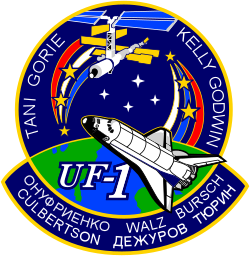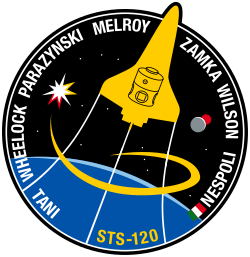Daniel Tani
| Daniel Tani | |
|---|---|
 | |
| astronaut NASA | |
| Státní příslušnost | USA |
| Datum narození | 1. února 1961, věk 61 |
| Místo narození | Ridley Park, Pensylvánie |
| Jiné zaměstnání | inženýr |
| Čas ve vesmíru | 131 dní 18 hodin 05 minut |
| Kosmonaut od | 1996 |
| Mise | STS-108, STS-120, Expedice 16 |
| Znaky misí | |
| Některá data mohou pocházet z datové položky. | |
Daniel Tani (* 1. února 1961, Ridley Park, Pensylvánie) je americký inženýr a astronaut NASA. Přestože se narodil v Ridley Parku v Pensylvánii, uvádí za své rodné město Lombard v Illinois.[1] Společně s Peggy Whitson provedl Tani 100. výstup do otevřeného kosmu (EVA) na Mezinárodní vesmírné stanici.
Vzdělání, kariéra
Tani získal v roce 1979 bakalářský titul na Glenbard East High School, Lombard, Illinois. Po zisku titulu bakaláře pracoval Tani jako konstruktér ve firmě Hughes Aircraft. V roce 1986 se vrátil ke studiu v oboru mechanického strojírenství na Massachusettském technologickém institutu, kde se specializoval na lidské faktory a skupinové rozhodování. Inženýrský titul získal v roce 1988.[1] Po promoci pracoval ve firmě Orbital Sciences Corporation mimo jiné na vývoji rakety Pegasus, která startuje z letadla.[1]
Lety do vesmíru
V dubnu 1996 byl vybrán jako kandidát na astronauta a od srpna 1996 prodělal výcvik v Johnson Space Center.[1] Po ukončení dvouleté přípravy se kvalifikoval jako specialista mise.[1]
Poprvé letěl Tani do vesmíru při misi STS-108, kde plnil funkci druhého specialisty mise. Cílem mise byla Mezinárodní vesmírná stanice, kam raketoplán dopravil posádku Expedice 4, více než tři tuny zásob a vědecké pokusy. Zpět na Zemi se raketoplánem vrátili astronauti Expedice 3. Tani strávil ve vesmíru více než 11 dní, přičemž provedl výstup do volného prostoru, při kterém byly vybaveny tepelnou ochranou výkyvné systémy panelů solárních článků.[2]
Po návratu z mise STS-108 byl Tani přidělen jako záložní palubní inženýr Expedice 9. Zpět do vesmíru se dostal až jako inženýr v Expedici 16. Na stanici ISS ho dopravil raketoplán Discovery při misi STS-120 27. října 2007. Jeden výstup do otevřeného kosmu absolvoval, když ještě raketoplán kotvil u stanice. Další čtyři až po odpojení raketoplánu v rámci Expedice. Původně stanovený termín návratu na Zemi s posádkou STS-122 byl kvůli poruše čidel ECO odložen o více než dva měsíce, a tak se Tani dostal na Zemi až 20. února 2008.
- STS-108 – Endeavour (5. prosince 2001 – 17. prosince 2001)
- STS-120 – Discovery (23. října 2007 – )
- Expedice 16 – ISS (27. října 2007 – 18. února 2007)
- STS-122 – Atlantis ( – 20. února 2008)
Osobní život
Je ženatý s Jane Egan, má dvě děti. Jeho koníčky jsou golf, létání, běh, tenis, hudba, vaření.[1]
Odkazy
Reference
V tomto článku byl použit překlad textu z článku Daniel M. Tani na anglické Wikipedii.
- ↑ a b c d e f NASA. Biographical Data - Daniel M. Tani, NASA Astronaut [online]. National Aeronautics and Space Administration [cit. 2008-09-16]. Dostupné v archivu pořízeném dne 2008-09-16.
- ↑ PDF. www.ian.cz [online]. [cit. 2008-09-16]. Dostupné v archivu pořízeném z originálu dne 2016-03-04.
Externí odkazy
 Obrázky, zvuky či videa k tématu Daniel Tani na Wikimedia Commons
Obrázky, zvuky či videa k tématu Daniel Tani na Wikimedia Commons - (česky) Životopis na MEK
- (anglicky) NASA Biography of Daniel M. Tani
- (anglicky) Spacefacts biography of Daniel M. Tani
Média použitá na této stránce
This patch commemorates the sixteenth expeditionary mission to the International Space Station (ISS). The design represents the conjunction of two unique astronomical events: a transit of the ISS across the surface of a full moon, and a nearly complete annular eclipse of the sun. The ISS is shown in its complete configuration, symbolizing the role of this expedition in preparing for the arrival and commissioning of international partner modules and components. The ISS transit across the moon highlights its role in developing the techniques and innovations critical to enable long-duration expeditions to the lunar surface and beyond.
This is the mission patch of STS-108. Space Shuttle Endeavour is seen approaching the International Space Station. Two astronaut symbols represent the crew commanders of both ISS expeditions. The ascending one represents cosmonaut Yury Onufriyenko of Russia. (The ascending astronaut symbol shows a flag of Russia.) The descending astronaut symbol represents Frank Culbertson of the USA. This represents crew rotation, as three stars are depicted on the symbols. The space shuttle crew members are depicted along the border while the ISS crews are depicted along the chevron on the border of the patch.
- This is the insignia for the STS-108 mission, which marks a major milestone in the assembly of the International Space Station (ISS) as the first designated Utilization Flight, UF-1. The crew of Endeavour will bring the Expedition Four crew to ISS and return the Expedition Three crew to Earth. Endeavour will also launch with a Multi-Purpose Logistics Module (MPLM) that will be berthed to ISS and unloaded. The MPLM will be returned to Endeavour for the trip home and used again on a later flight. The crew patch depicts Endeavour and the ISS in the configuration at the time of arrival and docking. The Station is shown viewed along the direction of flight as will be seen by the Shuttle crew during their final approach and docking along the X-axis. The three ribbons and stars on the left side of the patch signify the returning Expedition Three crew. The red, white and blue order of the ribbons represents the American commander for that mission. The three ribbons and stars on the right depict the arriving Expedition Four crew. The white, blue, red order of the Expedition Four ribbon matches the color of the Russian flag and signifies that the commander of Expedition Four is a Russian cosmonaut. Each white star in the center of the patch represents the four Endeavour crew members. The names of the four astronauts who will crew Endeavour are shown along the top border of the patch. The three astronauts and three cosmonauts of the two expedition crews are shown on the chevron at the bottom of the patch.
Emblem of Nasa's STS-122 mission.
- The STS-122 patch depicts the continuation of the voyages of the early explorers to today's frontier, space. The ship denotes the travels of the early expeditions from the east to the west. The space shuttle shows the continuation of that journey along the orbital path from west to east. A little more than 500 years after Columbus sailed to the new world, the STS-122 crew will bring the European laboratory module "Columbus" to the International Space Station to usher in a new era of scientific discovery.
The STS-120 patch reflects the role of the mission in the future of the space program. The shuttle payload bay carries Node 2, the doorway to the future international laboratory elements on the International Space Station. On the left the star represents the International Space Station; the red colored points represent the current location of the P6 solar array, furled and awaiting relocation when the crew arrives. During the mission, the crew will move P6 to its final home at the end of the port truss. The gold points represent the P6 solar array in its new location, unfurled and producing power for science and life support. On the right, the moon and Mars can be seen representing the future of NASA. The constellation Orion rises in the background, symbolizing NASA's new exploration vehicle. Through all, the shuttle rises up and away, leading the way to the future.




